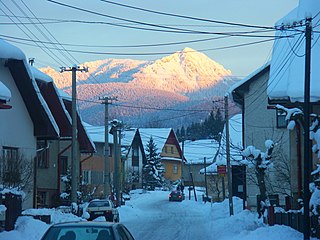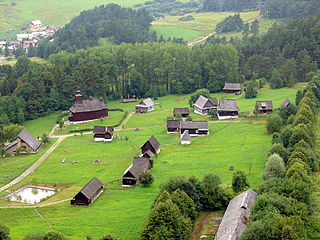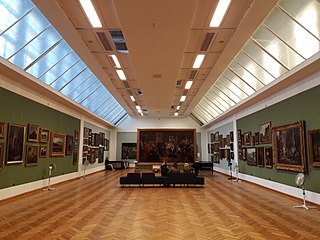
Białystok is the largest city in northeastern Poland and the capital of the Podlaskie Voivodeship. It is the tenth-largest city in Poland, second in terms of population density, and thirteenth in area.

Wasilków is a town in north-eastern Poland, in Białystok County, in Podlaskie Voivodeship, about 3 km north of Białystok, with 12 559 inhabitants (2022). It is a northern suburb of Białystok, situated on the Supraśl River.

Branicki Palace is a historical edifice in Białystok, Poland. It was developed on the site of an earlier building in the first half of the 18th century by Jan Klemens Branicki, a wealthy Polish–Lithuanian Commonwealth hetman, into a residence suitable for a man whose ambition was to become king of Poland. The palace complex with gardens, pavilions, sculptures, outbuildings and other structures and the city with churches, city hall and monastery, all built almost at the same time according to French models was the reason why the city was known in the 18th century as Versailles de la Pologne and subsequently Versailles de la Podlachie.

Białowieża is a village in Poland's Podlaskie Voivodeship, in the middle of the Białowieża Forest, to which it gave its name. The village is some 21 kilometres (13 mi) east of Hajnówka and 66 km (41 mi) southeast of the province capital, Białystok.

"ASTRA" National Museum Complex is a museum complex in Sibiu, Romania, which gathers under the same authority four ethnology and civilisation museums in the city, a series of laboratories for conservation and research, and a documentation centre. It is the successor of the ASTRA Museum that has existed in the city since 1905. Its modern life started with the opening of The Museum of Folk Technology in 1964, now The "ASTRA" Museum of the Traditional Folk Civilization.

National Museum of Folk Architecture and Folkways of Ukraine, is a 133.5 hectare open-air museum located at 1 Akademika Tronka Street, in the Pyrohiv neighbourhood of Holosiivskyi District, Kyiv, Ukraine. An architectural and landscape complex representing the major historical and ethnographic regions of Ukraine, it is dedicated to the preservation and study of regional Ukrainian folkways.

Zuberec is a village in northern Slovakia and a popular tourist center at the foothills of the Western Tatras. Zuberec features numerous accommodation facilities, restaurants, museum and a tourist information office.
Zelwa, is a village in the administrative district of Gmina Giby, within Sejny County, Podlaskie Voivodeship, in north-eastern Poland, close to the borders with Belarus and Lithuania. It lies approximately 11 kilometres (7 mi) south-east of Sejny and 104 km (65 mi) north of the regional capital Białystok.

Slovakia has around 14 open-air museums, or skanzens, showcasing the country's folk traditions, architecture, and economic history. The museums include examples of traditional buildings and furnishings, and many offer demonstrations of traditional handicrafts. The largest open-air museum is the Slovak Village Open Air Museum in Martin.

The National Museum of Ethnography is a museum of ethnography in Warsaw, Poland. It was established in 1888.

The Seweryn Udziela Ethnographic Museum of Kraków is a museum in Kazimierz, Kraków, Poland. It was established in 1902.

Białystok is one of the largest cultural centers in the Podlaskie Voivodeship. The attractions include performing arts groups, art museums, historical museums, walking tours of architectural / cultural aspects and a wide variety of parks and green spaces. Białystok in 2010 was on the short-list, but ultimately lost the competition, to become a finalist for European Capital of Culture in 2016.

The National Museum in Lublin is one of the oldest and largest museums in Eastern Poland, located in Lublin. It was created in 1914, and received its own building in 1923.

The Museum of Cieszyn Silesia in Cieszyn is one of the oldest public museums in Central Europe and the oldest public museum in Poland, set up by father Leopold Jan Szersznik in 1802.

Podlaska Opera and Orchestra in Białystok is a cultural institution in Białystok, capital of Podlaskie Voivodeship of Poland. It is the largest artistic institution in north-eastern Poland and the most modern cultural center in this part of Europe.

Podlaskie Museum in Białystok is the biggest museum of Podlaskie Voivodeship. It is based in Białystok, a city located in north-eastern Poland.

Army Museum in Białystok is a military museum located in Bialystok, the capital of Podlaskie Voivodeship in north-eastern Poland. It is the largest army museum in the region. First opened in 1968, since 1976 it has been operating as an independent museum unit with a macro-regional range. It is currently a self-governing cultural institution of the city of Białystok. As part of the Army Museum, until the end of 2016, there was a Branch, the Siberian Memorial Museum.

The Ethnographic Museum in Włocławek - a branch of the Kujawy and Dobrzyń Land Museum in Włocławek.

Maria Znamierowska-Prüfferowa (1898–1990) was a Polish ethnographer, professor at the Nicolaus Copernicus University in Toruń, founder and long-term director of the Toruń Ethnographic Museum, posthumously named after her. She was also an activist of the Polish Ethnological Society.



















